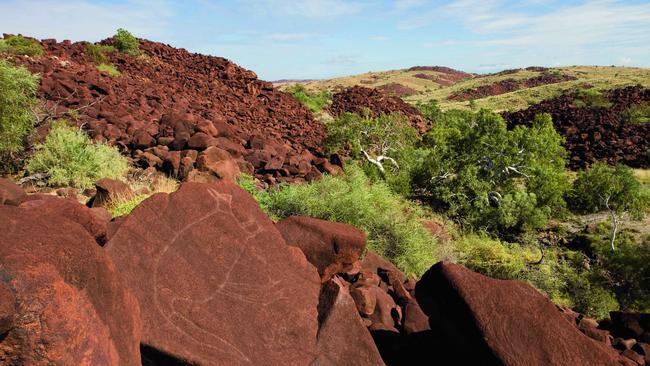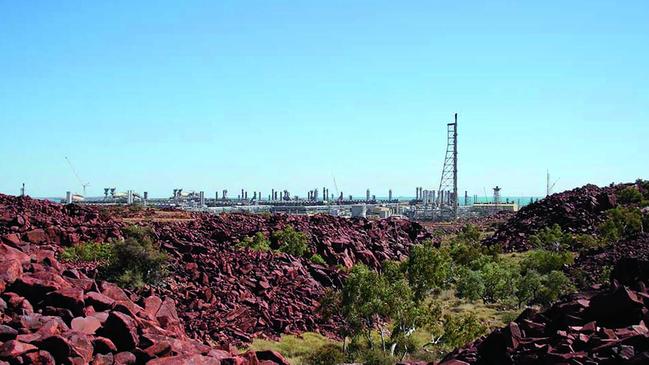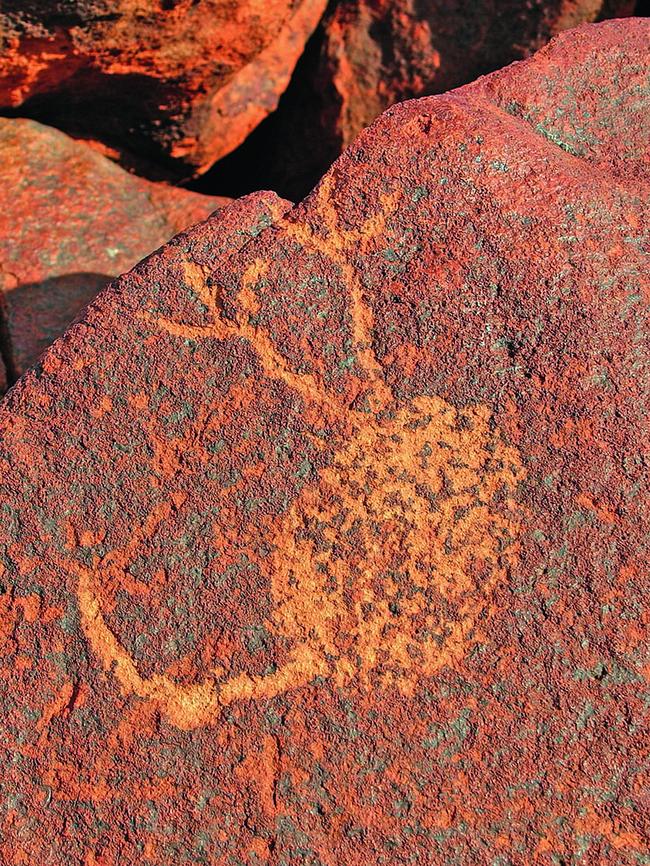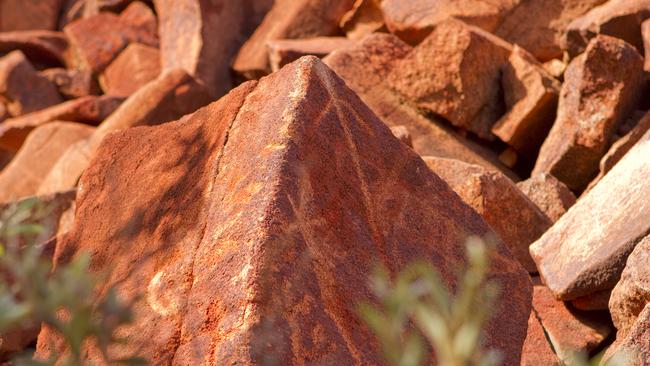‘Priceless’ Burrup Peninsula rock art at risk as monitoring halted by disputes
Efforts to protect the world’s largest collection of ancient rock art on the Burrup Peninsula are in disarray.

Efforts to protect the world’s largest collection of ancient rock art on the Burrup Peninsula are in disarray after the contractor hired to develop a new “world class” scientific monitoring system for the priceless art was secretly sacked from the job by the WA state government, amid an acrimonious falling out between business partners.
And the Australian can reveal that no independent scientific monitoring of the ancient petroglyphs on the peninsula has been conducted since the CSIRO walked away from the work in 2016, with sources saying no new system is likely to be in place for at least another two years.
The revelations throw doubts over whether the ancient rock art can be protected from the massive expansion planned for the industrial precinct by Woodside Petroleum, given no recent data exists on the condition of the largest ancient rock art collection in the world.
It also throws up questions about whether the state government of Premier Mark McGowan can make good on promises to list the rock art collection for UNESCO World Heritage status, and of its commitment to protect the priceless archaeological trove.
The Burrup Peninsula near Karratha in WA contains more than a million engravings, and experts believe the oldest could date back more than 30,000 years. Known as Murujuga by the Pilbara’s traditional owners, it is believed to be the site of the longest continuous production of rock art in the world.

In 2007, the Australian Heritage Council listed the rock art on the Burrup Peninsula and described it as “a masterpiece of human creative genius”.
But the site sits nestled next door to one of the biggest industrial complexes in the southern hemisphere – including the Woodside Petroleum-operated North West Shelf joint venture; Woodside’s Pluto LNG Project; Yara Pilbara’s ammonium nitrate plants and Rio Tinto’s nearby Dampier port facilities, one of the busiest bulk-handling ports in the world.
The controversy over whether heavy industry on the peninsula is damaging the ancient art has raged for decades, centred around whether acidic gases emitted by liquefied natural gas and ammonium nitrate plants are is eating away at the patina covering the weathered rocks in the area, into which the petroglyphs are etched, and will eventually destroy them.
Some of the petroglyphs have already been removed or destroyed as the industrial precinct was built, and the impact of industrial emissions on the rock art is also a matter of dispute.
From 2003 CSIRO conducted a monitoring program over the art but walked away in 2016, amid heavy criticism of the science behind its methodology, which had showed little damage to the art from industrial emissions.
In the wake of the decision, and under heavy pressure from conservation and indigenous groups to protect the ancient petroglyphs, the WA state government announced a reset of its strategy to protect the area, announcing it would develop a “world class” monitoring system, to help protect the precinct for future generations.
It took two years of consultations between the state government and stakeholders – including the Murujuga Aborignal corporation, Rio, Woodside, Yara and rock art groups – to establish a framework for a new monitoring system, before a tender for the work was finally released in mid-2019.
In February 2020 the state government awarded a tender for the work to Puliyapang Pty Ltd, a joint venture between NSW-based Aboriginal owned business Tocomwall Pty Ltd and WA engineering and consulting major Calibre.

At the time then WA environment minister Stephen Dawson said the partnership would work with subject matter experts from Curtin University, Artcare and the ChemCentre to “world best practice scientific monitoring and analysis program”.
The $7.2m contract would be largely funded by Rio, Woodside and Yara, but administered by the Department of Water and Environment Regulation with input from MAC.
The program of work published by DWER said field work and monitoring studies would begin in 2021, along with training of MAC rangers to carry out the work, with full implementation of the monitoring program in the second or third year of the contract.
That strategy now appears to be in tatters after DWER terminated Puliyapang’s contract in late April, amid a falling-out between Tocomwall and Calibre and accusations the joint venture failed to pay bills to subcontractors Curtin University – and to an arm of Calibre, which was managing the project.
An email exchange seen by The Australian, in response to questions regarding the matter to both Calibre and Tocomwall, indicates Tocomwall is preparing legal action against Calibre over its conduct in carrying out the contract.
Directors of Puliyapand – one from Calibre and another from Tocomwall, declined to comment on Wednesday, referring the issue to DWER and saying the terms of the contract prevented them from making public comment.
But the state government appears to have kept the contract’s termination a secret from Burrup stakeholders.
When contacted by The Australian, Woodside and Yara – who had agreed to fund the work along with Rio – all said they had not been advised by the state government that the contract with Puliyapang had been terminated. It is believed Rio was also not informed of the termination at the time.
It is understood the stakeholder reference group established as the state government’s point of engagement with companies, indigenous groups and the local community was only advised of the contract’s termination late on Wednesday, after The Australian sent questions about the issue to the office of new Environment Minister Amber Jade Sanderson.
The Murujuga Aboriginal Corporation did not respond to a request for comment on Wednesday and stakeholder reference group chairman Ron Edwards declined to comment, referring questions to the environment minister.
Puliyapang’s sacking leaves the development of a new monitoring program in limbo as the state government scrambles to find a new contractors to finalise the work and implement a new program.

Sources close to the program say much of the work promised for delivery in the first year of the contract has not been completed, and there is little chance a new program will be ready to roll out as scheduled.
Worse, documents published by DWER in April show that no independent scientific monitoring of the rock art has been carried out in the five years since CSIRO left the program in 2016, aside from some work conducted by Yara as part of its obligations under the federal Environment Protection and Biodiversity Conservation Act.
A spokesman for Yara said the company had conducted monitoring of seven petroglyphs close to its operations since 2017.
“Yara has employed independent specialists; one an archaeologist and former Registrar of Aboriginal Sites for the WA government, the other a globally-recognised heritage expert,” he said.
“Each year, this program has been submitted to and approved by the Commonwealth Minister for the Environment in accordance with Yara’s licence under the EPBC Act. Yara anticipates undertaking a monitoring program again in 2021.”
Conservation groups say lack of monitoring of potential damage to the ancient rock art throw doubts over whether it can be protected from the massive expansion of LNG facilities planned for the industrial precinct by Woodside Petroleum, approved this week by new state environment minister Amber Jade Sanderson.
Conservation Council of WA executive director Piers Verstegen said the termination of the monitoring contract lends weight to arguments the state government has never been serious about protecting the precinct’s heritage.
“The rock art monitoring strategy has been used as a cover to allow industrial expansion on the Burrup in connection with the LNG industry, even though this strategy has to date produced no data and appears unlikely ever to do so,” he said.

“These decisions are directly undermining the potential for World Heritage listing for the area because they will create additional threats to the heritage values that will be impossible to reverse before any protection occurs. Yesterdays’ further approval for the Pluto LNG expansion is the latest example of this pattern of decision making.”
Friends of Australian Rock Art (FARA) spokesperson Judith Hugo said the news the contract had been terminated was “concerning”.
“This new monitoring program has only just started. To hear that a hold has been called to it for the moment, we hope that will be sorted because it’s only with that proof that they’ll finally accept that the damage is being done,” she said.
“The rock art is being seriously damaged but they’re also approving more and more industry.”
A spokesperson for the Department of Water and Environmental Regulation confirmed on Wednesday that Puliyapang’s contract had been terminated.
“DWER terminated the contract with Puliyapang on April 30 due to breach of contract. A procurement process is currently underway and is expected to be finalised soon. No further comment can be made while the process is underway,” the department said.
“The department is working to ensure minimal delays to the program and a smooth transition to a new contractual arrangement to ensure the continuation of the program. It is anticipated that the date for field and laboratory studies to commence will still be late 2021.”

